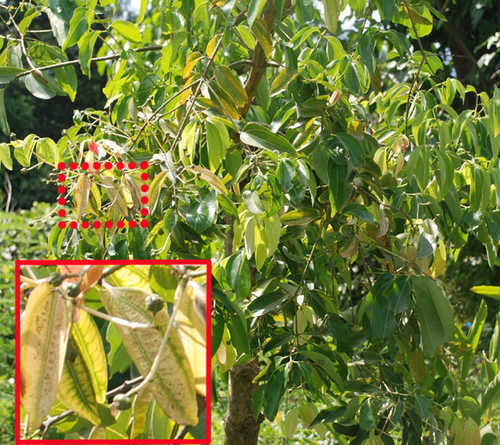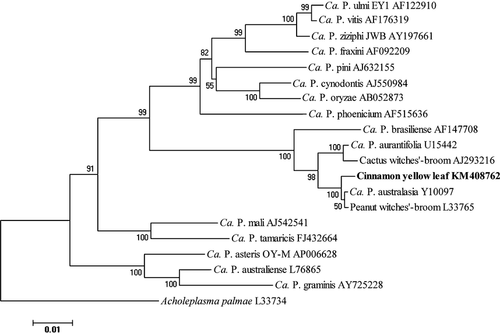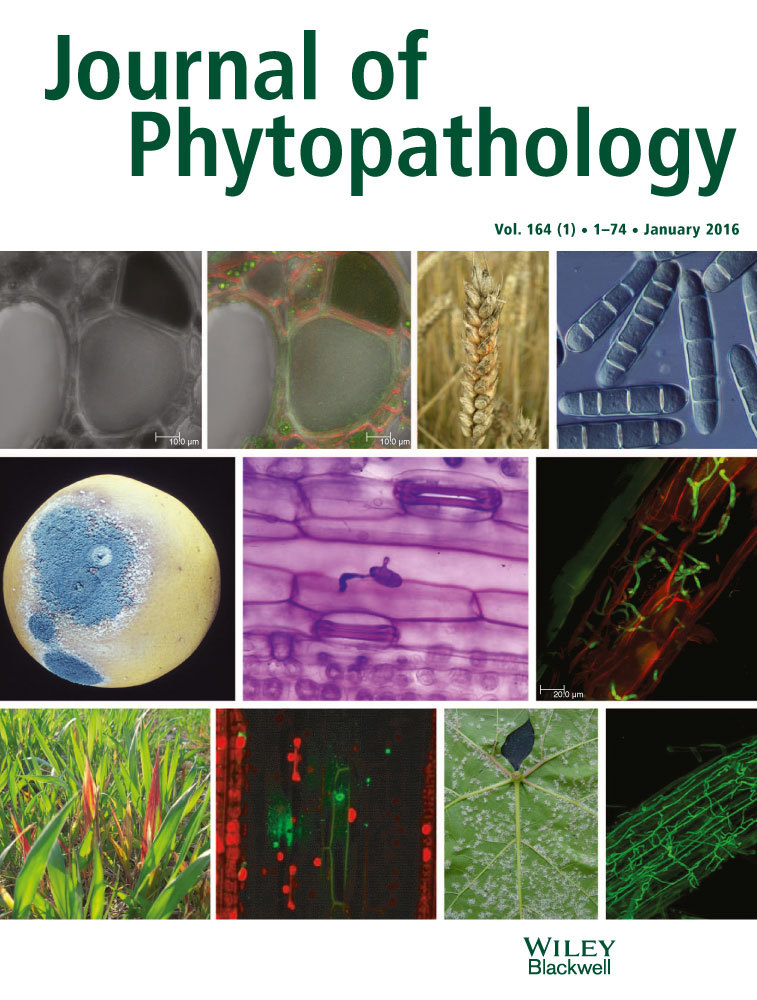Molecular Identification of a 16SrII-A Group-Related Phytoplasma Associated with Cinnamon Yellow Leaf Disease in China
Abstract
Chinese cinnamon (Cinnamomum cassia Presl), an evergreen tree native to China, is a multifaceted medicinal plant. The stem bark of cinnamon is used worldwide in traditional and modern medicines and is one of the most popular cooking spices. In recent years, cinnamon with pronounced yellow leaf symptoms has been observed in their natural habitat in Hainan, China. Phytoplasmas were detected from symptomatic cinnamon trees via polymerase chain reaction using phytoplasma universal primers P1/P7 followed by R16F2n/R16R2. No amplification products were obtained from templates of asymptomatic cinnamon trees. These results indicated a direct association between phytoplasma infection and the cinnamon yellow leaf (CYL) disease. Sequence analysis of the CYL phytoplasma 16S rRNA gene determined that CYL phytoplasma is a ‘Candidatus Phytoplasma australasiae’-related strain. Furthermore, virtual restriction fragment length polymorphism pattern analysis and phylogenetic studies showed that CYL phytoplasma belongs to the peanut witches’-broom (16SrII) group, subgroup A. This is the first report of a 16SrII group phytoplasma infecting cinnamon under natural conditions.
Introduction
Phytoplasmas are non-helical, cell wall-less phytopathogenic bacteria, belonging to the Mollicutes class (Firrao et al. 2004). These plant pathogens inhabit the sieve cells of phloem tissue and induce disease symptoms such as virescence, phyllody, sterility of flowers, proliferation of auxiliary or axillary shoots, abnormal elongation of internodes, generalized stunting and unseasonal yellowing or reddening of the leaves (Lee et al. 2000; Du Toit 2014; Maejima et al. 2014). Associated with these diseases, phytoplasma can be transmitted via dodder and graft and by phloem-feeding insects like leafhopper and planthopper (Hemiptera) (Weintraub and Beanland 2006; Firrao et al. 2007; Hogenhout et al. 2008; Weintraub 2008). Due to their inability to grow in cell-free medium, phytoplasmas are mainly classified based on 16S rRNA gene sequence instead of by the traditional methods which are applied to culturable prokaryotes (Firrao et al. 2004, 2005; Brown et al. 2007; Wei et al. 2007; Zhao et al. 2009).
Chinese cinnamon, Cinnamomum cassia Presl (Lauraceae), is a small evergreen tree that is cultivated in tropical and subtropical regions. The tree has significant economic importance and has been used for traditional medicines in China for at least 2000 years. China is the largest producer of cinnamon bark with 80% of world production (Wei et al. 2006). Consequently, cinnamon bark and cinnamon bark oil are major export commodities in China.
In 2013, we conducted phytoplasma disease surveys and observed a disease on cinnamon trees in Xinglong Tropical Botanical Garden, Hainan Province, China. Infected trees displayed branches with only yellow leaves; however, other branches appeared healthy. One year later, many cinnamon trees displayed generalized decline with yellowing leaves on most branches. The objective of this study was to identify the causal agent of this cinnamon tree associated disease in Hainan, China.
Materials and Methods
Samples of both infected and asymptomatic cinnamon trees (C. cassia Presl) were collected from Xinglong Tropical Botanical Garden, Hainan Province, China.
Total nucleic acid was extracted from both symptomless and diseased samples. Midribs (0.5 g) from cinnamon trees were cut into small pieces with a scissors. We used the phytoplasma enrichment and cetyltrimethylammonium bromide (CTAB) extraction procedure described by Ahrens and Seemuller (1992).
A nested polymerase chain reaction (PCR) was employed for the detection of phytoplasmas using the universal primers P1/P7 (Deng and Hiruki 1991; Schneider et al. 1995) followed by R16F2n/R16R2 (Gundersen and Lee 1996) which amplified a phytoplasma 16S rDNA segment (approximately 1.2 kbp). The oligonucleotide sequences of the primers used in this study are as follows: P1, 5′-AAGAGTTTGATCCTGGCTCAGGATT-3′; P7, 5′-CGTCCTTCATCGGCTCTT-3′; R16F2n, 5′-GAAACGACTGCTAAGACTGG-3′; and R16R2, 5′-TGACGGGCGGTGTGTACAAACCCCG-3′.
For the cloning of 16S rDNA, the target DNA fragments were ligated into the plasmid vector pMD18-T (TakaRa, Dalian, China) and the recombinant plasmid was used to transform Escherichia coli according to the manufacturers’ instructions. The inserts were sequenced with an automated DNA sequencer (ABI Prism model 3730XL, Applied Biosystems, Inc., Carlsbad, CA, USA) using M13-47 and RV-M primers (Sangon, Shanghai, China). The obtained sequence was uploaded to GenBank (Accession No. KM408762). To identify and classify the phytoplasma associated with cinnamon yellow leaf (CYL) disease, the sequence was subjected to similarity analysis and virtual restriction fragment length polymorphism (RFLP) analysis using the iPhyClassifier software (Zhao et al. 2009). Cladistic analysis was performed on the 16S rDNA sequence obtained (GenBank Accession No. KM408762) using mega5 software (Tamura et al. 2011).
Results and Discussion
Approximately 40 cinnamon trees grow in Xinglong Tropical Botanical Garden; more than 20 trees showed symptoms in 2014. The most typical symptoms of naturally infected cinnamon trees were general leaf yellowing (Fig. 1). The trees with severe infections suffer leaf loss and general decline.

Using total DNA samples from both yellow and asymptomatic leaves as template DNA, no fragments of expected size (1.8 kbp) were apparent after 35 cycles of PCR with primer pair P1/P7. However, products approximately 1.2 kbp in size were obtained after nested PCRs with primer pair R16F2n/R16R2. No amplification occurred with either primer pair subjecting samples collected from asymptomatic cinnamon trees and the water controls to this process.
We used the interactive online tool iPhyClassifier (Zhao et al. 2009) to perform sequence similarity analyses. The tool found that the 16S rRNA gene sequence (GenBank Accession No. KM408762) shares 99.2% similarity with that of the ‘Candidatus Phytoplasma australasiae’ reference strain (GenBank Accession No. Y10097). The CYL phytoplasma is a ‘Candidatus Phytoplasma australasiae’-related strain. The virtual RFLP pattern derived from the CYL phytoplasma 16S rDNA F2nR2 fragment is identical to (similarity coefficient of 1.00) the reference pattern of 16Sr group II, subgroup A (GenBank Accession No. L33765). The CYL phytoplasma is a member of 16SrII-A.
A phylogenetic tree was constructed using the minimum evolution approach of the mega5 program (Tamura et al. 2011). Phylogenetic analysis clearly demonstrated that CYL phytoplasma shared a common ancestor with the peanut witches’-broom phytoplasma (L33765) and Ca. Phytoplasma australasiae (Y10097), all of which are members of the peanut witches’-broom phytoplasma group (16SrII) (Fig. 2).

Cinnamon has been utilized in traditional medicines for at least 2000 years. Diverse antimicrobial activities of cinnamon have been reported in various studies (Hili et al. 1997; Chang et al. 2001; Brenda Gende et al. 2008; Aneja et al. 2009; Goni et al. 2009). Here, we report a ‘Candidatus Phytoplasma australasiae’-related strain (CYL phytoplasma) infecting cinnamon under natural conditions. To our knowledge, this is the first report of a 16SrII group phytoplasma infection in cinnamon. The mechanism of how phytoplasmas survive in cinnamon is unknown and potentially interesting.
Unseasonal yellowing and branch deformity (e.g. witches’-broom and fasciation) are the most common symptoms of plants infected by phytoplasmas (Lee et al. 2000). Phytoplasmas induce yellowing that is similar to yellowing form viruses and nutrient deficiency. However, phytoplasmas produce systematic yellowing and branches of the same tree may show different symptoms in the early stages of infection. Yellowing in leaves infected by virus often mottle or discolour in ringed patterns. Nutrient deficiency yellowing is regional and has no disease centre in the field. In this study, the symptomatic yellowing is typical phytoplasma-induced yellowing.
Hainan Province is located in the tropical regions of China, and the warm and humid climate benefits insect vectors. The insect vectors in Hainan include a large number of species that are very abundant. Identifying potential insect vectors of the phytoplasmas associated with yellow leaf disease is vitally important for cinnamon cultivation. Further research on insect vectors will help us control this disease.
Acknowledgements
This work was supported by the National Natural Science Foundation of China (No. 31201492 and No. 21407177), the Fundamental Research Funds for Environment and Plant Protection Institute, CATAS (No. 2012hzs1J001), and the Natural Science Foundation of Hainan Province (No. 314101).




